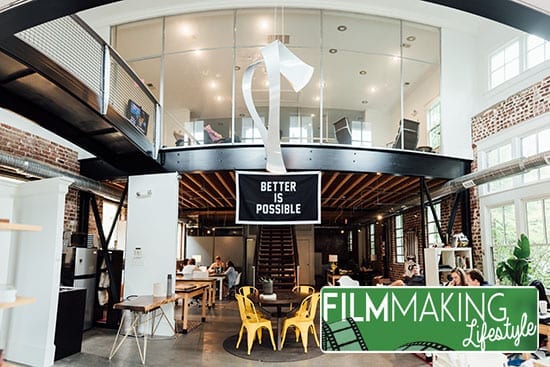Last time around, Gio let us know the first stages of setting up to ‘pitch a video client.’ If you haven’t read Part 1 yet, then do so first by following this link.
Pitching to a client can be a nerve-wracking event. Money is on the line, and if you haven’t pitched to a client before, it can be even more stressful.
But no worries, I’ll show you the best techniques to keep your cool and ace the pitch.
Step 1: Rehearse The Budget
You have to be 100% solid on every choice of the budget you are negotiating.
If you offered them 3 budgets as I recommended in this article, then be ready to justify each item.
They may have questions, but do not overwhelm them with film jargon. Just stick to the basics, and offer qualities over technicalities.
For example, the client asks “What’s a dolly?”
Don’t say “it’s a small cart that holds the camera.”
Technically, that’s what it is, but the real question the client is asking is: what is it for? Why do I have to pay for it?
The correct answer to the client, the quality answer, is: “It’s to make every shot smooth and beautiful, so the video comes out great.”
So just remember: quality over technicalities.
Step 2: Rehearse The Pitch
Make sure you have as many visual resources as you can to help sell your ideas when you pitch a video client.
Here are some ideas:
- Bring your iPad preloaded with your reel.
- Grab pictures off Google images to set the mood of your ideas.
- Make a Power Point presentation with 90% pictures and 10% words. Clients will love it.
The last thing you want to do is pass out pamphlets and thick binders with your entire project and force them to read while you’re presenting. Don’t do that.
Rehearsing your speech and what you’re going to say to sell them on your ideas is fine, but actually what’s more important is double checking your equipment.
- Do you have everything online in a Dropbox/Google Drive account?
- Do you have it saved on your laptop/hard drive?
- Have all of your presentation materials saved in 3 locations: Dropbox, local hard drive, and a USB thumb drive.
Possible scenarios:
The internet is out at the client location, use your laptop.
Your laptop is stolen, use the USB thumb drive.
The last thing you want happening is having to reschedule the entire meeting because Murphy’s Law came into effect.
Step 3: Arrive Early
Even if the client’s office is 2 blocks away from you, get there early. You want to be in the lobby or parking lot of the client at least 20 minutes early.
Rehearse your pitch, and double check that everything is preloaded and ready to present.
Step 4: Pitching
More than likely the potential client will not be by himself. He will have one or more people sitting with them to help make the final decision on whether to hire you or not.
We have seriously pitched to a round table filled with six people.
So if you’re nervous talking in front of several people, find someone in your group (either fellow business partner or fellow freelancer friend) to help you pitch.
Usually having at least one person with you will help put your nerves at ease.
Your pitch should be short and sweet.
For a commercial or short video, if it goes over 10 minutes to present 2 or 3 ideas, it’s too long.
After you’re done presenting your materials, ask if they have any questions.
Be patient while answering their questions. Just imagine they don’t know anything about filmmaking so be very specific and clear. They may even interrupt you during your presentation, so be ready for that.
Here are the awesome guys at Business Film Booth with a short video on pitching your business:
Your Business In 60 Seconds” width=”500″ height=”281″ src=”https://www.youtube.com/embed/w28idSfNBNc?feature=oembed” frameborder=”0″ allow=”accelerometer; autoplay; clipboard-write; encrypted-media; gyroscope; picture-in-picture” allowfullscreen>
After 30 to 45 minutes, the meeting should be wrapping up.
If it’s shorter than 30 minutes, that may be a bad sign. It means they have made their decision and will more than likely not proceed in using your services.
If the meeting goes more than 45 minutes, I will assume the meeting went very well. Bonus points if the client asks a lot of questions and they show you around the company.
In my experience, we went to pitch ideas to Forever 21, and we were out by 25 minutes and our ideas were declined.
When we pitched to another clothing company, we were done after an hour that included a tour of the company. They ended up using us for 3 videos.
Here’s a great presentation on pitching by the esteemed Guy Kawasaki:
Step 5: Email Them The Next Day
The following day, send a short and sweet email.
“Dear Potential Client,
It was great meeting with you yesterday. Thank you for taking the time to hear my ideas, I really appreciate it. If you have any questions, please feel free to contact me any time. Thank you again.
—Awesome Freelancer”
That’s it.
Step 6: Do Not Wait
Don’t wait for them to respond, you have to continue the hustle.
Search for the next client, and if you have other potential clients already lined up, then start the process of pitching ideas to them.
Just pretend you failed at yesterday’s meeting, figure out what you did right and wrong, then keep moving.
The important thing is to just keep moving forward and on to the next client.
Step 7: Get Confirmation
If you get an email talking about the price of the budget from the client within 3 days of the pitch, then that’s a very good sign.
More than likely, they’ll go ahead with the project and hire you for your services.
Once you get the confirmation email, send your contract with the specifics of the project and get them to sign it.
Congratulations! You got your first project! Move on to Step 8.
If you haven’t heard anything after a week, go ahead and email them.
“Dear Potential Client,
I hope you’re doing well. I was wondering if you had any further questions on our potential project. Please let me know, thank you.”
That’s all you have to say. They will either say:
A) “Sorry, we’ve been busy,” aka, we’ve been looking around to see if we can get a cheaper price.
Or B) “Sorry, this project isn’t the right fit for our company at this time.”
If they respond with B), send them his email:
“Thank you for your reply. If we think of any potentially great ideas in the further for your company, would you be interested in hearing us out?
We would really like to work with you, and maybe down the line we’ll have the right project that we can collaborate on.”
As long as you didn’t spill coffee directly over the head of the potential client, then they will respond positively.
Unless you have a great/genius idea, I wouldn’t recommend contacting them until after 3 months.
Three months is just the right amount of time for them to almost completely forget about your last pitch.
When they say yes this time around, they will go in with a blank slate and will judge you on your current pitching skills, which after 3 months of constant pitching to clients should be honed sharp.
Step 8: Repeat Step 1 To Pitch Other Video Clients
Eat a hearty breakfast, and start the entire process all over again with another client. These are the steps you should take repeatedly in order to pitch a video client.
So, have you got pitch meetings set up? What are you going to do the next time you pitch a client for video business? Let us know in the comments below!
Giordany Orellana is writing a book on how to start your own video business. He’ll be releasing exclusive new chapters here on Filmmaking Lifestyle.
Says Gio: Join me in the discussion – hate it or love it, I want to know. Feel free to drop feedback in the comments below. And get this out there and seen by others using the share buttons below.
Matt Crawford
Related posts
2 Comments
Leave a Reply Cancel reply
This site uses Akismet to reduce spam. Learn how your comment data is processed.





Great, these 5 simple steps will be very useful for creating our Video Pitch for Impac Hub.
Thanks, d1Mm. Let me know if we can help you with anything else.